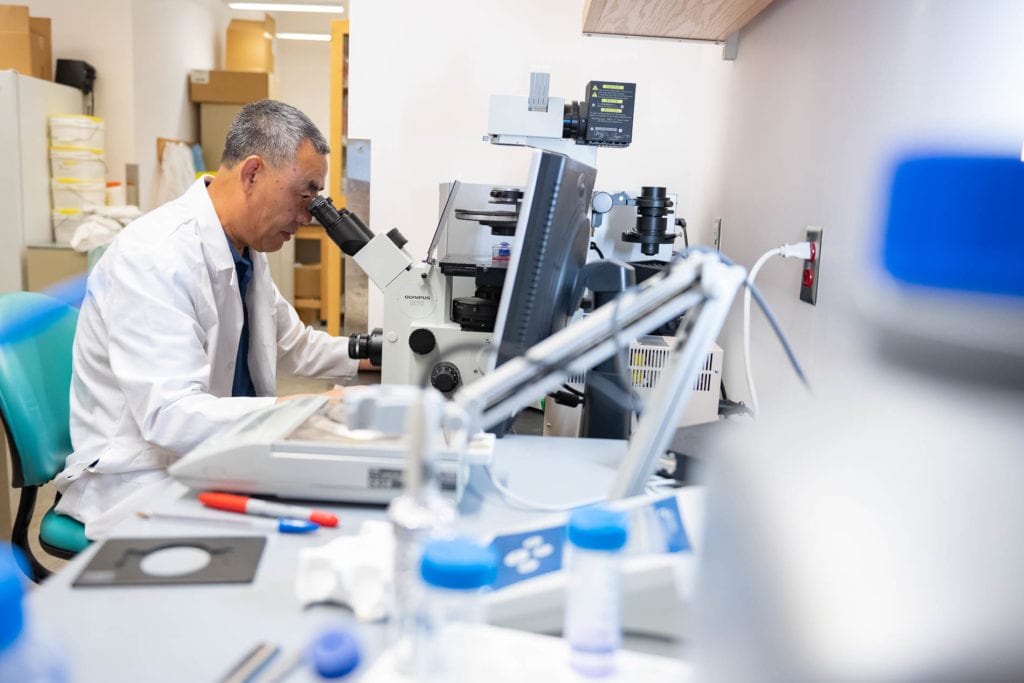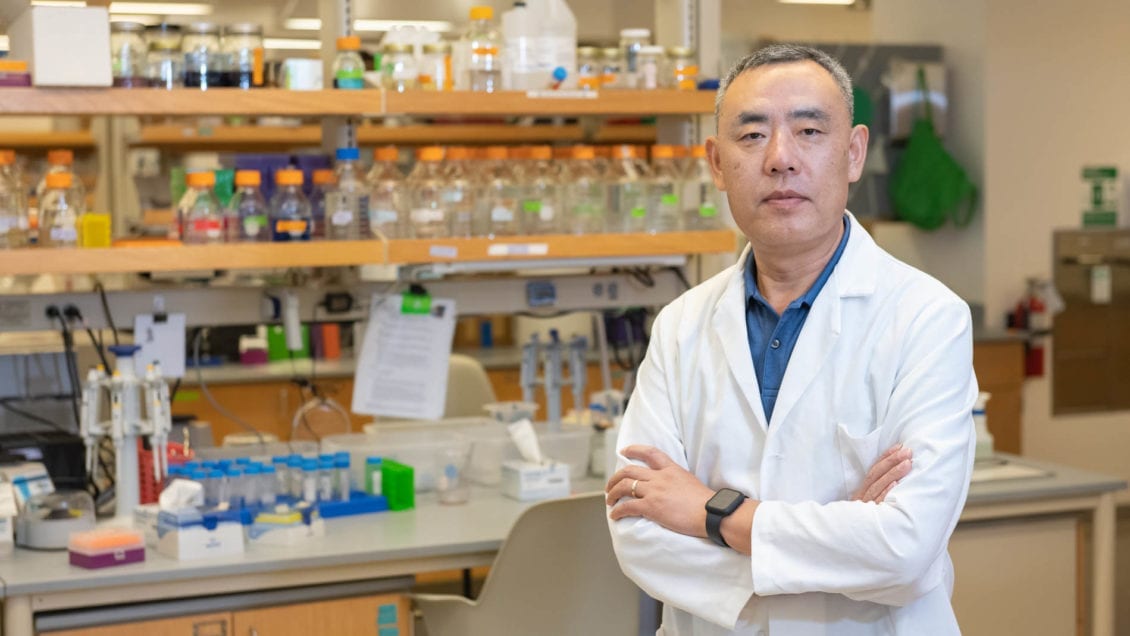Study lays groundwork for possible new immunotherapy for the world’s most commonly diagnosed cancer
It sounds like a plot from a Quentin Tarantino movie — something sets off natural killers and sends them on a killing spree.
But instead of characters in a movie, these natural killers are part of the human immune system and their targets are breast cancer tumor cells. The triggers are fusion proteins developed by Clemson University researchers that link the two together.
“The idea is to use this bifunctional protein to bridge the natural killer cells and breast cancer tumor cells,” said Yanzhang (Charlie) Wei, a professor in the College of Science’s Department of Biological Sciences. “If the two cells are brought close enough together through this receptor ligand connection, the natural killer cells can release what I call killing machinery to have the tumor cells killed.”
It’s a novel approach to developing breast cancer-specific immunotherapy and could lead to new treatment options for the world’s most common cancer.
One in eight
About one in eight women in the U.S. and one in 1,000 men will develop invasive breast cancer during their lives. Breast cancer is the second leading cause of cancer death in women in the U.S., trailing only lung cancer. The American Cancer Society estimates that about 43,600 U.S. women will die from the disease this year.
About one in eight women in the U.S. and one in 1,000 men will develop invasive breast cancer during their lives. Breast cancer is the second leading cause of cancer death in women in the U.S., trailing only lung cancer. The American Cancer Society estimates that about 43,600 U.S. women will die from the disease this year.
Immunotherapy harnesses the power of the body’s immune system to kill cancer cells.
“Very simply, cancer is uncontrolled cell growth. Some cells will become abnormal and have the potential to become cancer,” Wei said. “The immune system can recognize these abnormal cells and destroy them before they become cancer cells. Unfortunately for those who develop cancer, the immune system is not working very well because of gene mutations and environmental factors. The result is that the cancer cells won the fight between the immune system and the tumors.”
Most breast cancer targeting therapies target one of three receptors: estrogen receptors, progesterone receptors or epidermal growth factor receptors. However, up to 20 percent of breast cancers do not express these receptors. These cancers are known as triple-negative breast cancer. Triple-negative is the most lethal subtype of breast cancer because of high heterogeneity, high metastasis frequency, early relapse after standard chemotherapy and lack of efficient treatment options.
In this novel research, Wei and his researchers targeted prolactin receptors. Prolactin is a natural hormone in the body and plays a role in breast growth and milk production during breastfeeding. Breast cancer cells overexpress prolactin receptors.

“When people are diagnosed with breast cancer, and it’s called triple-negative, it is not good news,” Wei said. “This has the potential to give patients another option.”
Over 90 percent of breast cancer cells express prolactin receptors, including triple-negative breast cancer cells.
Wei and his team developed a bifunctional protein. One part is a mutated form of prolactin that can still bind to the prolactin receptor but blocks signal transduction that would promote tumor growth. The other part is an extracellular domain of major histocompatibility complex class I chain-related protein (MICA).
Activating the killers
When the MICA binds to the prolactin receptor, it activates the natural killer cells.
“One of the things tumor cells do is to inhibit natural killer cell activation, so we use these artificial bifunctional proteins to connect natural killer cells and activate them to enhance the killing of the breast cancer cells without increased cytotoxicity,” Wei said.
Wei is now seeking funding for an animal model study to confirm the results.
One big question is whether the bifunctional protein will bring natural killer cells to healthy cells in the body that also express prolactin receptors and kill them, too, causing severe side effects.
If the animal model studies are successful, the potential new treatment could move to human clinical trials.
“If we had the funding now and everything is what we expected in the animal model study, we could be in clinical trials in five or six years,” he said. Wei said he expects the conversion from in-vitro and animal studies to clinical trials to be easier for this potential immunotherapy than others in the past because the protein created by the Clemson researchers uses human natural killer cells and breast cancer cells.
Developing new immunotherapy for cancer is nothing new to Wei. His research combining tumor cells with dendritic cells, an important part of the body’s adaptive immune system, led to a dendritoma vaccine that proved effective in melanoma, renal cell carcinoma and neuroblastoma patients. The vaccine was patented and licensed to three biotech companies. Two companies are still pursuing the vaccine therapy or related therapy.
A dream
“It is my dream that someday we can create a group of these bifunctional proteins that could be used for other cancers by shifting the target molecule. We’d have the one part of the bifunctional protein that targets natural killer cells. The other part would target other cancer types that have unique markers,” Wei said.
PLOS One, a peer-reviewed scientific journal published by the Public Library of Science, recently published Wei’s breast cancer and natural killer cell study. It is titled “MICA-G129R: A bifunctional fusion protein increases PRLR-positive breast cancer cell death in co-culture with natural killer cells.”
Clemson doctoral graduate Hui Ding is the paper’s lead author. Other authors include Clemson doctoral student Garrett Buzzard; Clemson research assistant Sisi Huang; Michael Sehorn, associate professor in Clemson’s Department of Genetics and Biochemistry; and Ken Marcus, a Clemson chemistry professor.
The research was partially supported by a Clemson Support for Early Exploration and Development (SEED) Grant (CU SEED2017).
The College of Science pursues excellence in scientific discovery, learning and engagement that is both locally relevant and globally impactful. The life, physical and mathematical sciences converge to tackle some of tomorrow’s scientific challenges, and our faculty are preparing the next generation of leading scientists. The College of Science offers high-impact transformational experiences such as research, internships and study abroad to help prepare our graduates for top industries, graduate programs and health professions. Clemson.edu/science
Get in touch and we will connect you with the author or another expert.
Or email us at news@clemson.edu

